Check Out
The Check Out function allows you to assign assets to a customer, employee, or vendor. You can optionally assign a due date and time by which the assets should be removed.
Assets can also be checked out on a Android and iOS device.
Note:
- The barcode labeled "scan for a quick check in" printed on the check out receipt is only for use with the Web application. The barcode cannot be used with a mobile device.
- Capture Transaction Geo Location Settings - If the Capture Transaction Geolocation is enabled, then the Geolocation - View Map link will appear on the History screen, once you complete the Check-out transaction. Refer to History - View Map.
- Note on Custom Fields: If custom fields are not filled and are marked as required and read-only, then the user without the Edit Read Only permission will not be able to add/edit the values in the custom field or move the asset to the queue. In this case, a notification message will appear to the user that the administrator has marked this field as read-only. Refer to the topic Edit Read Only Fields for more details.
- Click on Transactions > Check Out.
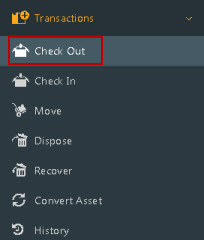
- The Check Out screen will appear.
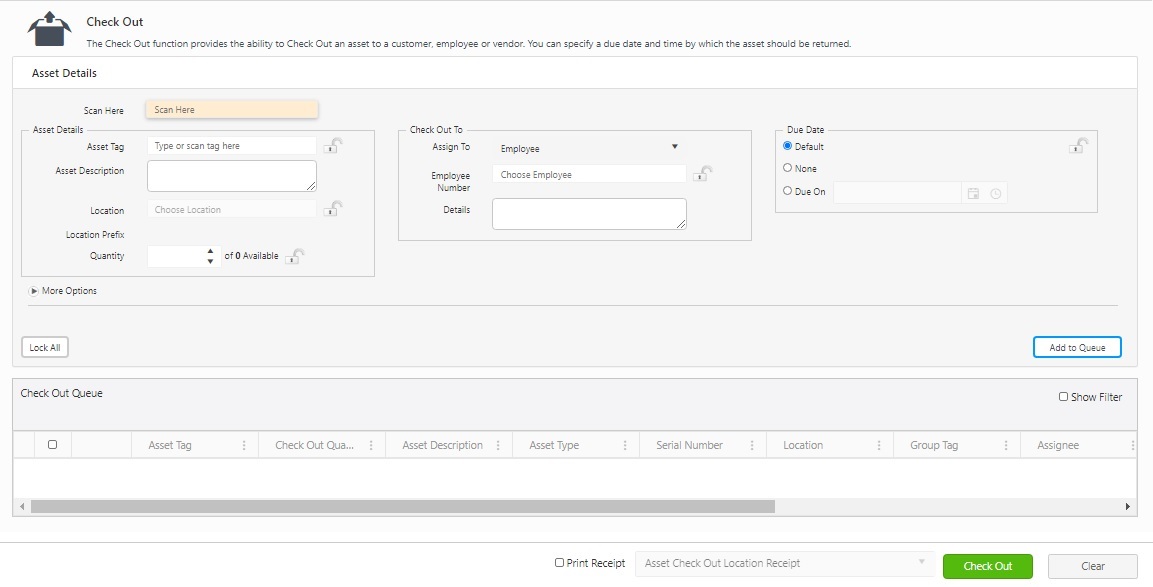
Note that certain fields on this screen have the option to be "locked." When a field is in the locked state, it will preserve the data you've input for future transactions. This feature comes in handy when you're either adding multiple assets to a specific location or checking out several assets to a single customer. To lock a specific field, simply click on the lock icon. If you want to lock all fields with this icon at once, you can use the Lock All button for quick action. Conversely, if you wish to unlock all the fields to allow for new information, you can select Unlock All.
For guidance, click here for information on how to lock fields.
Asset Details
- Scan Here - Click on the Scan Here field, then scan an asset tag, location, and/or customer/vendor/employee. The Scan Here field functions as a Quick Lookup. You can type in a full or partial Employee/Customer number or an asset tag to perform a search.

- Asset Tag - Enter/select the asset tag. A Group Widget will appear if the selected asset is a "Group" or an "Asset in a group". Also, refer to Transact As Whole topic.
- If the selected Asset is in a Group and Transact as Whole feature is enabled for that Group
- The group containing the asset has the "Transact as Whole" feature enabled. When you select an asset (i.e., a child asset), the asset tag field will automatically select and display the parent asset containing the child asset. A Group Widget icon will appear next to the asset tag field in the checkout queue. Also, you can select the child asset using the group widget and proceed with the checkout transaction.
Example - Consider three groups - Container 1, Container 2, and Container 3. Container 1 contains assets FA_1, FA_2, and FA_3.
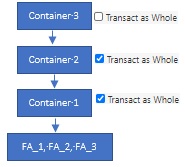
Container 1 and Container 2 have the "Transact as whole" feature enabled.
If you select FA_1, the parent group i.e., Container 2, with the "transact as whole" feature enabled, will get selected.
Note that you can also select FA_1, Container 1, or Container 3 using the group widget.
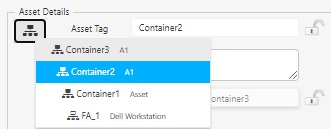
- If the selected Asset is in a Group and Transact as Whole feature is disabled for that Group
- The group containing the asset has the "Transact as Whole" feature disabled. When you select an asset (i.e., a child asset), the asset tag field will select and display the child asset. It will not swap the child asset with the parent asset. You can also select the parent asset using the Group Widget icon.
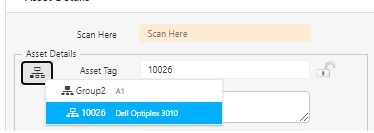
- If the selected Asset is a Group and Transact as Whole feature is enabled for the Group
- The asset that is a group has the "Transact as Whole" feature enabled. When you select an asset that is a group, the asset tag field will verify all the parent assets and select and display the parent group with the "transact as whole" feature enabled. You can select the sub-group/sub-group without sub-items using the Group Widget icon.
Example - Consider three groups - Container 1, Container 2, and Container 3. Container 1 contains assets FA_1, FA_2, and FA_3. Container 1 and Container 2 have the "Transact as whole" feature enabled.

Suppose you selected Container 1, the parent group, i.e., Container 2, with the "transact as whole" feature enabled, will get selected and displayed on the asset tag field. Note that you can also select Container 1, Container 1 with no sub-items, or Container 3 using the group widget.
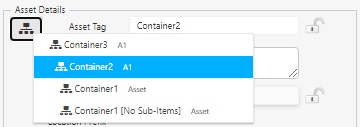
Similarly, if you select Container 2, the asset tag will select Container 2 as the parent "Container 3" has the "transact as whole" feature disabled.

- If the selected Asset is a Group and Transact as Whole" feature is disabled
- The asset tag field will select the group with no sub-items. You can also select the whole group.
Example - Consider three groups - Container 1, Container 2, and Container 3. Container 1 contains assets FA_1, FA_2, and FA_3. Container 1 and Container 2 have the "Transact as whole" feature enabled. The "Transact as Whole" feature is disabled for Container 3.
If you select Container 3, the asset tag will select and display Container 3 with no sub-items. Note that you can also select the whole group.


- The Description and From Location get automatically filled.
- Note that the location field will display the Site-Location /Site-Parent Location - Location on hover.

- Asset Prep Time will appear below the Asset Description field if "Checkout Lead time" is set for the selected Asset. Checkout Lead time is the preparation time (for example, clean-up, installation/un-installation) required for an asset before checking-out to another person.
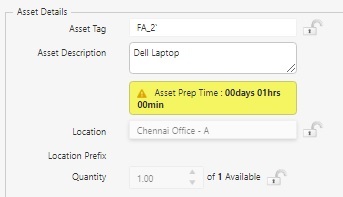
- Enter the quantity you want to check out in the Quantity field. The number available for check out appears to the right of the Quantity field. This field will be a read-only Asset.
- Force Check Out - Using this option, you can force checkout an already checked-out asset/group to a new assignee. So, click on the checkbox to force checkout an asset/group to a new assignee. This field will appear if the Always Force Check Out option under Assets in Settings is enabled/checked.
- Current Assignee - This will display the assignee's name to whom the asset is last checked out. You can select the new assignee in the Check Out To section.
Note - The Force Check Out is supported only for fixed assets. You cannot force check out multi-quantity assets.

Check Out To
- Assign To - Select Customer, Employee, or Vendor from the drop-down menu.
- Customer, Employee, or Vendor Number - Select the Customer, Employee, or Vendor number. This is a mandatory field.
- Details - Enter the details, if any.
Note: You can also search for a customer, employee, or vendor in the Scan Here field.
Due Date
- Due Date - There are three options - Default, None, and Due On. Refer to Settings - Default CheckOut Due Type to set the default check out due type.
- Default - When using this option, the due date is based on the check out length set for the selected asset or asset type. If you have multiple assets you are checking out to a customer, and each asset has a different check out length (set on the New/Edit Asset page or New/Edit Asset Type page), each asset may have a different due date.
- None - There will be no due date for any asset included in this transaction.
- Due On - Select a custom due date using the calendar and time icons. Each asset included in this transaction will have the due date selected.
More Options
- Click on More Options. Move to Location, and the Notes field will appear. This option is used when you want to move the asset to a new location along with the check out transaction. Add Notes (if any).
Note: Make sure to select the assign the asset to a guardian, i.e., Customer, Employee, or Vendor number field.

Choose Move To Location. The Move To Location field drop down will also display the Groups as a location. You can move the asset to a Group.
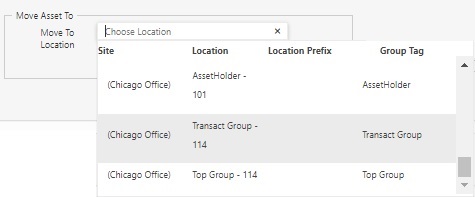
Custom Fields
A custom field for an asset can be added through Form Customization. Refer to the topic Adding Custom Fields on the Form Customization page. Now you can make the custom field visible and/or required for the Transaction screen. If the custom field is visible or required or both, then the Asset Details section of the Check Out screen will display the custom field.
- Enter the values in the Custom field.

- After entering all the information, click the Add to Queue button. The asset will be added to the Check Out Queue at the bottom of the screen.
IMPORTANT:
- Please note that after all the fields have been entered, the Asset with a due date set as Default will automatically move to the Check Out Queue at the bottom of the screen.
- In the Check Out Queue, a Group Widget icon will be next to the Asset Tag field. Refer to Step 4 and Group Widget's topic for more details.
- Note: - The Group Widget prevents users from performing transactions on the same asset/group twice. It will recognize the colliding records and unchecks all other colliding records, leaving only the most recent record changes checked. Hence, the same asset cannot be added more than once.
- If a parent Group is already added in the grid with the "Transact as Whole" attribute and you add any of its child assets, then the parent asset is unchecked and showing an error sign, and the child asset gets added at the top.
- If a child is already added in the grid and you add the parent asset with the "Transact as Whole" attribute, then the child asset is unchecked and shows an error sign, and the parent asset gets added to the grid at the top.
- If the parent asset is not "transact as whole " you can add both parent and child assets.
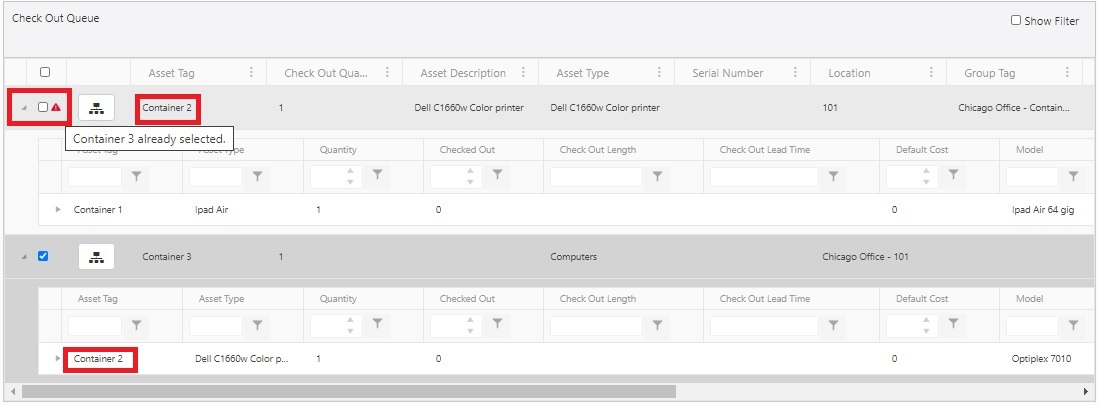
Check Out Queue
- If you want to update the Quantity, Due Date, or Move Asset To fields related information in the Check Out Queue, select the checkbox in front of the asset. The information will populate in the Asset Details and More Options section. Update the details and click on the Update button.
Note: The Quantity field can also be updated in the Check Out Queue. The Quantity should not exceed the available quantity. If you enter more than the available quantity, a message will appear.
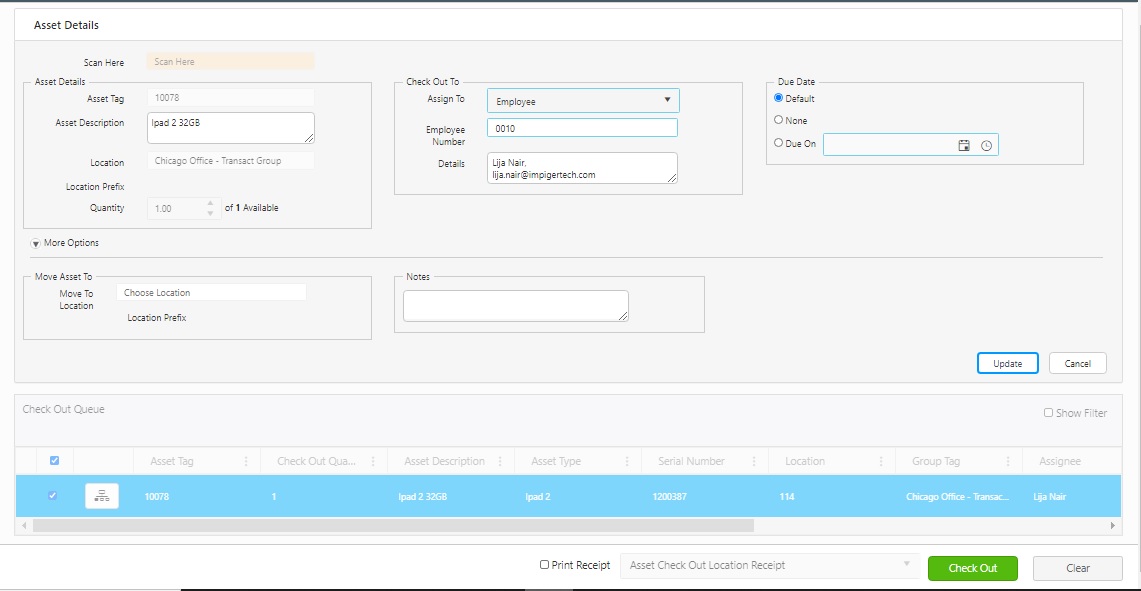
- When you have finished adding assets, ensure all assets you want to check out are "checked" in the Check Out Queue.
Note: You MUST select the assets you want to check out in the Check Out Asset Queue. Assets in the Queue are selected by default.
- Select Print Receipt if you want a printout of a receipt of this transaction. The receipt will have a barcode for Quick Check- In. By default, there will be a receipt heading.You can also change it. The Print Receipt checkbox will be checked (read-only) if the Always Print receipt option is enabled in the settings.
Note: If the pop-ups are blocked, and you cannot view the print receipt, Refer to Popups and Redirects to allow pop-ups and to view the print receipt.

- Click on the Check Out button.
Note: Keep in mind that Check Out transactions are limited to 50. This means that you can only check out 50 assets in each transaction.
Error Message: A message "Insufficient purchase quantity available to fulfill the request due to prior check-out requests." will appear if the purchased quantity is insufficient.
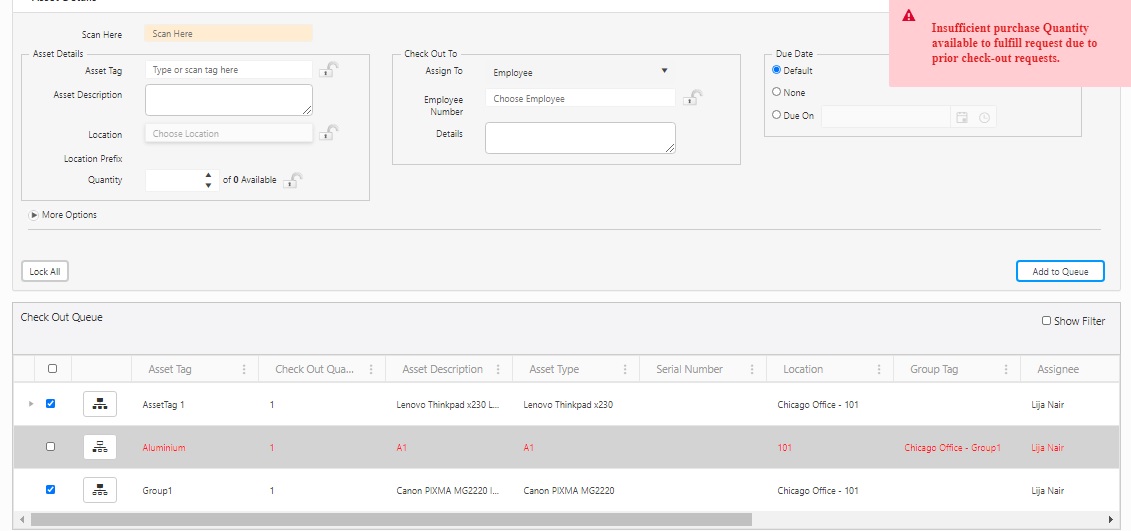
- A message will appear indicating that "Asset is Checked out" and a Print Receipt will get generated (if checked before Check Out).

Group Widget
The Group Widget on the transaction page supports the behavior of the Group on a Transaction grid. This helps the user specify their intention of the transaction on an asset. It always ‘remembers’ the selected asset and the group(s) that the asset is in.
The Group Widget icon will appear when you select a 'Group" or the "Asset within a Group.
 - This indicates that it is an entire group and you are performing a transaction on the whole group. In the image shown below, Container > Box > 10282 and 10283.
- This indicates that it is an entire group and you are performing a transaction on the whole group. In the image shown below, Container > Box > 10282 and 10283.

 - This indicates that the asset is a child asset/in a group, and you only perform transactions on this one child asset.
- This indicates that the asset is a child asset/in a group, and you only perform transactions on this one child asset.

 - This indicates that the asset is a parent/group (or top-level asset) and the transaction is being performed on a top-level asset only.
- This indicates that the asset is a parent/group (or top-level asset) and the transaction is being performed on a top-level asset only.

FAQs - Refer to Knowledgebase - Knowledgebase > Cloud > AssetCloud for FAQs. Example: How to extend or change the Due Date on a checked out asset?
Note: Use of the resources described here requires internet access.


![]()




















 - This indicates that it is an entire group and you are performing a transaction on the whole group. In the image shown below, Container > Box > 10282 and 10283.
- This indicates that it is an entire group and you are performing a transaction on the whole group. In the image shown below, Container > Box > 10282 and 10283.
 - This indicates that the asset is a child asset/in a group, and you only perform transactions on this one child asset.
- This indicates that the asset is a child asset/in a group, and you only perform transactions on this one child asset.
 - This indicates that the asset is a parent/group (or top-level asset) and the transaction is being performed on a top-level asset only.
- This indicates that the asset is a parent/group (or top-level asset) and the transaction is being performed on a top-level asset only.